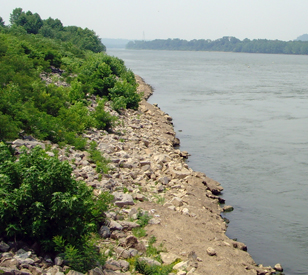Dissolved Oxygen Monitoring at Hydroelectric Facilities

Hydroelectric power generation may alter levels of dissolved gases in waters downstream from the dam, which can cause negative impacts on the ecosystem. For this reason, monitoring of dissolved oxygen (DO) is often required by regulatory agencies such as the Federal Energy Regulatory Commission (FERC). Automated monitoring systems can ensure that regulatory requirements are met and harmful effects on the environment are avoided.
Potential Impacts of a Hydroelectric Dam on DO

Typical Dissolved Oxygen Monitoring System
An effective DO monitoring system should provide real-time DO measurement data with alarms for early warning when threshold values are approached or exceeded. Multiple sensor placements upstream, at the intake, tailrace and downstream are often established to provide background data, comparative measurements and redundancy.
While sensors may be placed on buoys in some situations, hydropower dams generally lend themselves to structure-mounted installations where the sensor is placed into a perforated deployment pipe that allows flow to the sensor for accurate measurement. The sensor may be secured at a fixed position within the pipe and easily removed from the water for maintenance and calibration.
For data logging, a mast-mounted NexSens X3 environmental data logger can transmit data wirelessly in real-time via 4G LTE cellular or Iridium satellite communications to the WQData LIVE web datacenter, where data can be viewed and exported and alarms configured. The X3 logger is compatible with most industry-standard DO sensors including those from YSI and includes multiple sensor ports to accommodate situations where sensors are at multiple depths.
Other sensors that the system can easily be expanded to accommodate include total dissolved gas (TDG) in cases where supersaturation is a concern, multiparameter sondes for advanced water quality data, and weather sensors.
Contact a NexSens Applications Engineer today to discuss your DO monitoring application.

Case Studies
Dissolved Oxygen Monitoring Below Dams
The Oklahoma Water Resources Board is a governmental agency that looks to protect and improve the quality of life for the state’s citizens through managing Oklahoma’s water resources. That mission is achieved through many means, including providing financial assistance where needed, granting permits and monitoring water quality in reservoirs and downstream from hydropower dams.
Read MoreMeasuring Dissolved Oxygen For Hydropower
In southwest Kentucky, the town of Smithland isn’t home to many people. Its population as of 2010 barely broke 300, according to the U.S. Census Bureau. Nevertheless, it is the namesake of a prominent dam operated by the U.S. Army Corps of Engineers along the Ohio River: Smithland Locks and Dam. This dam has for decades been used by the Army Corps as a portal for barge and shipping traffic up and down the Ohio River. In 2010, the Corps helped to support a new purpose for the locks and dam by working with American Municipal Power (AMP) Ohio on a new hydropower installation at Smithland, which was fully completed in 2017.
Read MoreBaseline Dissolved Oxygen Levels
Willow Island, West Virginia is a small community along the Ohio River. In 1978, it was probably best known as the location of a large, coal-burning power plant. But nowadays, the town has a future in hydropower. American Municipal Power (AMP) Ohio, an electric utility company, has been financing the construction of a new hydroelectric facility that will use the Ohio River’s water to provide clean energy to the region. The company is retrofitting an existing structure owned by the U.S. Army Corps of Engineers, the Willow Island Locks and Dam.
Read More






